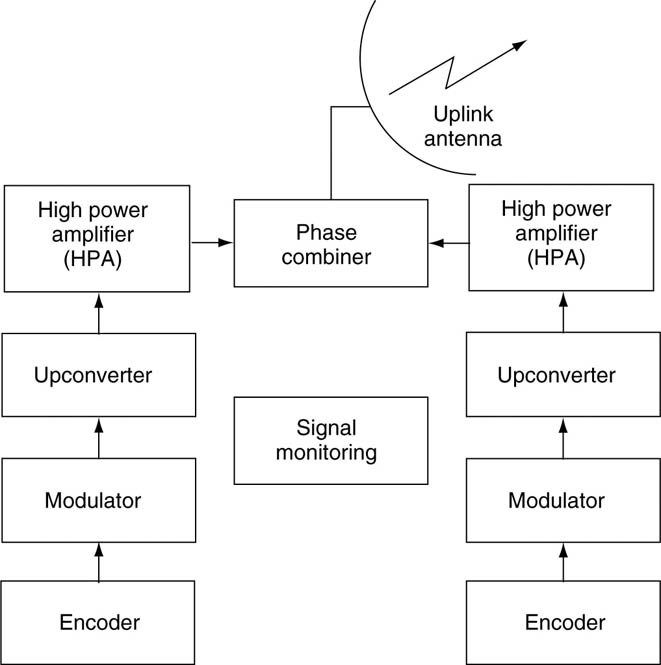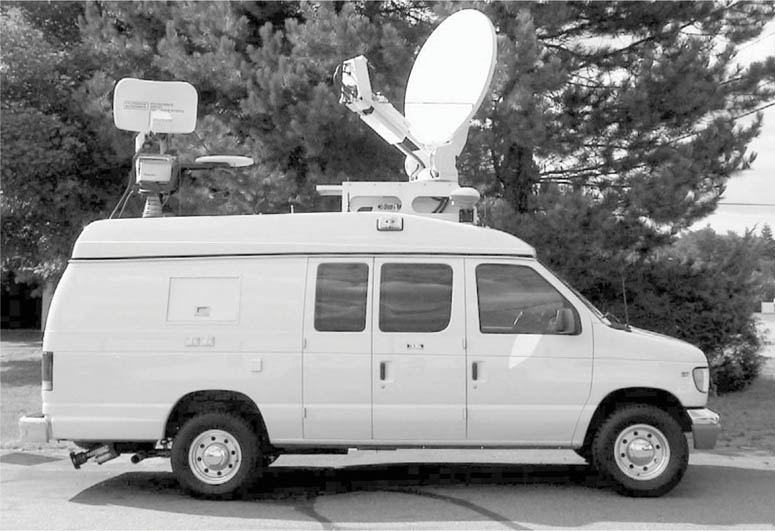SNG vehicles
SNG vehicles can be built on a variety of types of base vehicles such as towed trailers, estate cars, SUV/MPVs, pick-up vehicles, panel vans, box-body vehicles and even combined tractor units for towing production trailers.
However, in Europe the majority of SNG vehicles, sometimes referred to as satellite newsgathering vehicles (SNVs), are constructed on panel vans weighing between 3500 and 7500 kg. Some of the following explanations also apply to ENG microwave vehicles, particularly the means of providing electrical power.
The primary purpose of an SNV is to allow operational deployment to be accomplished more quickly than with a flyaway, and to have a number of additional facilities to be built-in so that they are also rapidly available once on-site.
These facilities typically include an on-board generator to provide electrical power, baseband signal production, signal routing, and bidirectional studioremote communications.
One of the principal characteristics of achieving fast deployment is, of course, having the antenna already mounted on the vehicle. The antenna can be controlled so that it can be pointed at the satellite from the comfort of the vehicle interior. It is common to have an antenna that is mounted on the roof and which is motorized for remotely adjusting azimuth, elevation and polarization.
The SNV has a number of sub-systems fitted to it beyond the basic satellite uplink system, so in addition it usually has the following installed:
• electrical power generator system
• stabilizing jacking system
• installed broadcast equipment.
Electrical power generator
Whereas a flyaway relies on power being provided from somewhere else, either from a building supply or from a separate generator, the SNG truck, depending on the size of the vehicle, usually has one of the following three types of electrical system:
• Self-contained generator driven by an engine separate from the vehicle road engine.
• Inverter system, where the road engine drives a 12 V/24 V alternator which then supplies 115 V/230 V via an inverter.
• Power take-off systems (PTO) where the road engine drives a generator either via a belt or indirectly via a specially equipped vehicle gearbox.
As with powering flyaways, it should be noted that whichever type of power system is used, the whole area of electrical power on location is fraught with difficulties. The power supply to the uplink from whatever type of generating system is likely to fail at some point, and some (wise) uplink operators have taken to having two sources available on a vehicle, with one acting as a standby emergency source. The reason for the likelihood of failure is, as we have already pointed out, generators are notoriously unreliable because of the less than ideal conditions they are often operated in.
There is also a potential safety issue where power is provided from an external input instead of from the on-board generator – often referred to as ‘shore-power’.
The condition of the incoming supply cannot be necessarily known, and it is usual to provide protection by use of a residual current device (RCD) which will turn off the power in the event of an electrical fault on the vehicle.
An RCD operates by sensing when the current in the live and neutral supply are not equal and opposite. Any imbalance is usually due to a path to earth due to excessive leakage and/or a fault situation.
Stabilizing jacking system
The vehicle usually requires a stabilizing jacking system to ensure that the antenna stays ‘on station’, as any movement of the vehicle could result in the movement of the antenna.
Movement of the vehicle can result from either people getting in and out or wind rocking the vehicle (e.g. if the wind is coming broadside onto the vehicle or from other vehicles passing by at high speed). It is common to provide either a two- or four-point stabilizing system, with either two jacks at each rear corner of the vehicle, two at the middle of the vehicle on each side, or four jacks, one at each corner.
The jacks can be manually, electrically or hydraulically operated. The most sophisticated stabilizing systems have computer-controlled stabilizing of the vehicle, with an on-board sensor feeding back the status of vehicle stability.
Manual systems are usually fitted to smaller lower cost vehicles, but the time taken to prepare the vehicle for operation is slower. It is possible on some vehicles not to have any stabilization if the antenna is small, as having a wider beamwidth than larger antennas, a slight movement of the antenna will not move it off-station.
Level of redundancy
Redundancy gives protection against failure of part of the system, and is an important factor to consider if the system is being used to cover an important event or story.
An SNG system may have part or all of its electronic equipment duplicated to give a degree of redundancy. Normally it is not necessary to duplicate any of the mechanical components, save for perhaps having a spare length of flexible waveguide that interconnects the HPA to the antenna.
The level of redundancy can be varied according to the requirement. It might perhaps be sufficient to add a second HPA and upconverter – this would give partial redundancy.
To achieve greater redundancy another modulator should be added. The additional HPA can either be combined with the primary HPA via a phase-combiner, or made available as a hot-spare via a waveguide switch.
A hot-spare is a part of the system which is switched on and in a fully operational state ready for rapid changeover in the event of a failure – conversely, a cold-spare is not switched on and ready! Additionally for a digital system, it might be decided that the digital modulator and the encoder should be replicated to achieve full redundancy.
The decision as to what level of redundancy is required or desired is not an easy one. In such a complex array of equipment as an SNG system, failures are inevitable at some point during the system’s life, and even full redundancy can never remove that risk totally – it simply minimizes it. Companies that hire SNG systems to broadcasters regard higher levels of redundancy as a priority so that the exposure of risk of failure to their clients is minimized.
Redundancy

Other organizations, particularly the global broadcasters who are primarily servicing their own outlets, prefer to reduce the capital cost, size and weight of the system and work with minimal redundancy, willing to take the risk of an occasional failure in return for a lower capital cost and lower revenue costs in shipping smaller flyaway systems around the world.
Multiple programme paths
It is now a common requirement to provide more than one programme path from a single SNG link. This may be to provide differing sources of material to the destination simultaneously, either off-tape or ‘live’, or to service different destinations simultaneously.
For whatever reason, there are two methods of providing multiple paths. One is to provide two separate uplink chains that are combined just before the input to the antenna – this is the ‘RF solution’.
The second method can only be achieved with a digital uplink – the ‘digital solution’, and that is to multiplex two or more programme paths (or ‘streams’) in the digital domain by cascading a number of digital compression encoders together to provide a single digital data stream to the uplink chain.
This is called MCPC. In a DSNG system, there are numerous permutations possible by using a combination of both of these methods, such that you could have two RF chains, each fed by a number of digital compression coders.
Hybrid SNG/ENG trucks
Of course, some broadcasters try to have the best of both worlds – with the use of combined trucks. These are vehicles that have both a satellite uplink and a terrestrial microwave link, and are called either hybrid or ‘dual purpose’ ENG trucks.
The advantages of this approach are clear – you can either use the satellite uplink where you cannot get a clear microwave path out, or save on the satellite cost and use terrestrial microwave where it is possible. There is an added bonus in locations where you can achieve both a satellite link and a terrestrial microwave link – you can either feed two separate programme feeds out on each path, or achieve diversity and protection by feeding an important programme out in both directions, hence protecting it against failure on either route.
There is a particular attraction if there is a digital COFDM terrestrial microwave link being used. Whether the programme signal is going via satellite or terrestrial microwave, the signal has to be coded as an MPEG-2 signal. This means that there are savings in the amount of equipment required.
On the other hand, if it is a fully digital DSNG uplink with an analogue terrestrial microwave link, the disadvantage is that the pictures will need to be converted back to analogue before they can be transmitted over the terrestrial link. This does not save any equipment.
Hybrid SNG/ENG microwave truck (© Wolf Coach Inc.)

